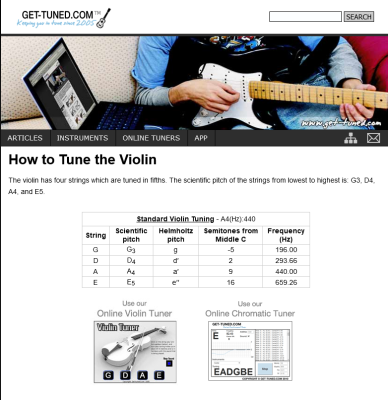Welcome to our forum. A Message To Our New and Prospective Members . Check out our Forum Rules. Lets keep this forum an enjoyable place to visit.
Currently working on errors from the latest (SimplePress) forum update. Many issues have been resoled and others are being worked on. Thank you for your patience.
 Topic RSS
Topic RSS



 (7 votes)
(7 votes) New member
 Offline
OfflineRegulars










@clare g
Welcome to the Forum! Congrats on your Christmas violin!
Have you tuned your violin strings with a tuner? You always want to make sure your strings are in tune before you play so that you are learning proper finger placement.
This chart shows the turning frequencies (hertz) of each open string
(from
https://www.get-tuned.com/how-.....violin.php )
And the video after it demonstrates what each open string sounds like:
This video describes the finger placement on the E string to get the F.
And this video shows the open E string & the F being played with a tuner in the background:
Hope that helps! 
Characterize people by their actions and you will never be fooled by their words.
Regulars
 Offline
Offline



Best method to find each note is to first tune the violin using a tuner. Then finger each string for each note in the scale while watching the tuner. Slide your finger up/down the string until the tuner says you're on the note you're wanting to create.
For example; on the E string, tune the E on the open string. Then place your first finger where you think F is and bow on the E string while watching the tuner. If your finger isn't placed correctly, move your finger up if you're too low and down if you're too high. Add the next finger on the E string for G and repeat. Do this for all strings and all finger positions/spacing.
You can download free tuners from the App store. Some are more useful than others but they all work.
Once you get the correct finger placements for the strings, a bit of tape across the fingerboard will help you learn where to put your fingers. You can buy the tapes already made or make them yourself by cutting 1/4" wide strips from a roll of painters tape and sticking them on the fingerboard under the strings. Don't stick the strips down tight after first applying them. You want to double check that the strips are in the correct places by fingering the strings on top of them and bowing while watching the tuner. If they're wrong, move them. If they're right, press them down until they're stuck tight.
Eventually you'll learn where to finger and take them off. When you do, some alcohol on a rag or tissue will remove the glue residue.
Regulars
 Offline
Offline








@clare g -
Welcome to the Fiddlerman Forum!
Great advice & videos from everyone above!
It's all about the finger placement intervals, the distance between pitches, whole steps/tones and half steps/tones!
If you have a 1st finger tape on your violin, it will show where to place your 1st finger to play the 1st whole step/tone on each of your strings - F# is the 1st whole step/tone on the E string.
It can be confusing, because F is only a half step/tone on the E string - so if your E string is in tune, F can be found in between the nut (at the top of the fingerboard) and the 1st finger tape. If you are familiar with a piano keyboard, you will notice there is NO black key between E and F - but there is a black key between A and B, D and E, G and A, to associate with your other 3 strings.

- Emily
New member
 Offline
OfflineMouse said
I don't know what you are doing, but here is a link. The web page has a video as well as a PDF showing finger placement. The F is played back from where you would expect it. It is not even with the B on the A string. Probably not the best way to explain it, low first finger position.https://violinspiration.com/al.....df-charts/
🐭
Thanks everyone, after reading all your reply and applying them I now have a properly tuned violin.
Thanks again. Happy New Year
1 Guest(s)


 Log In
Log In Register
Register












